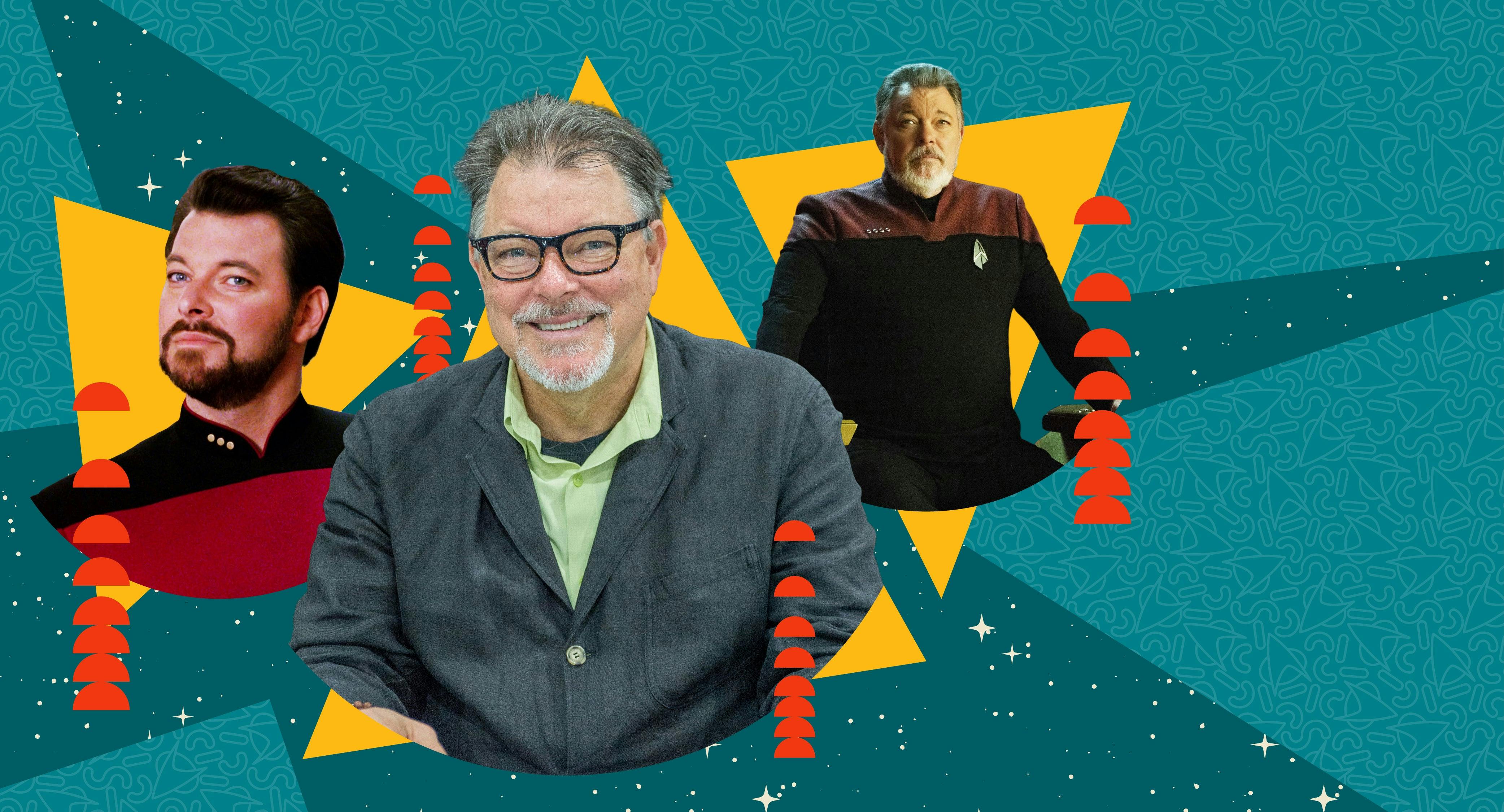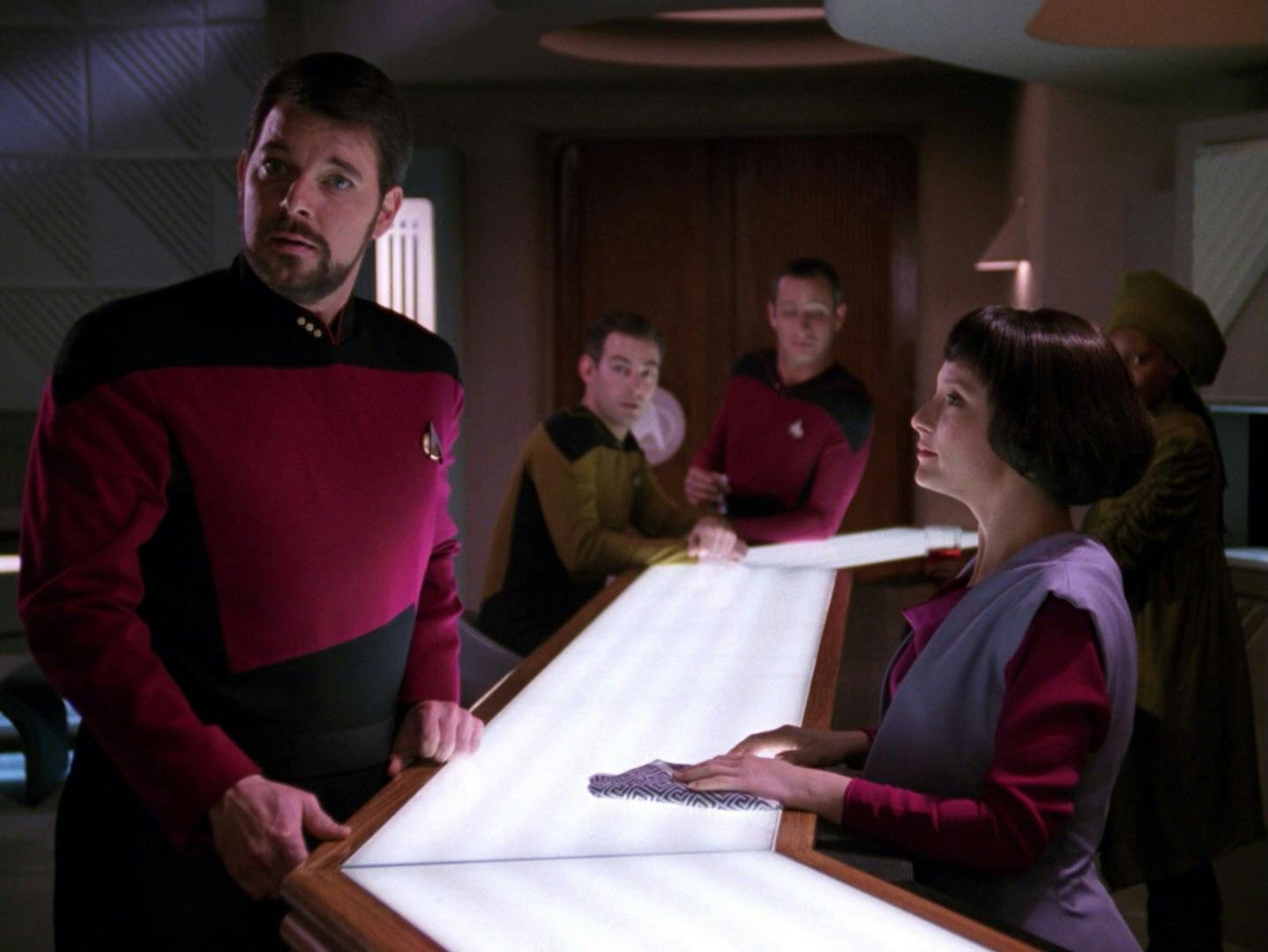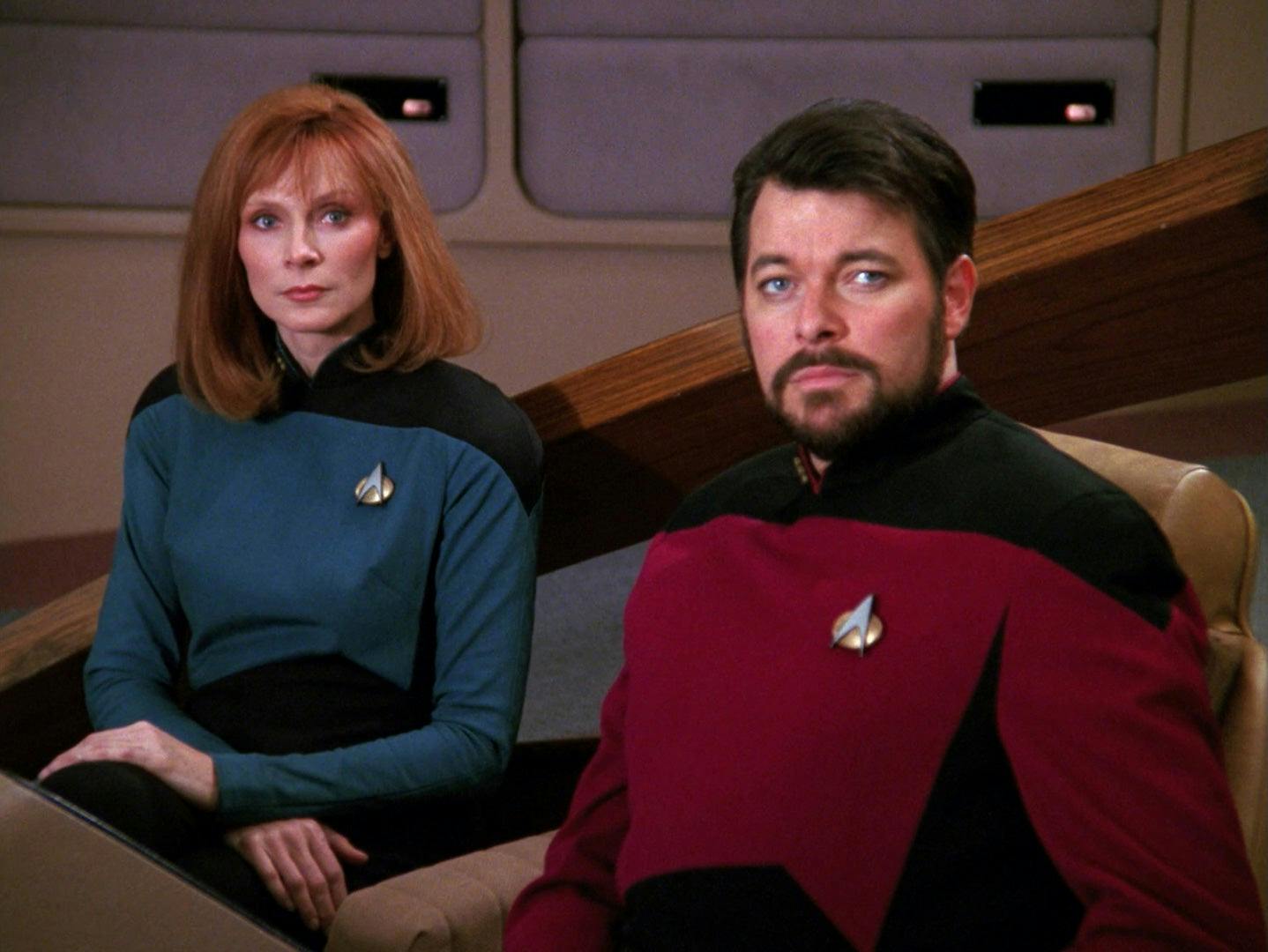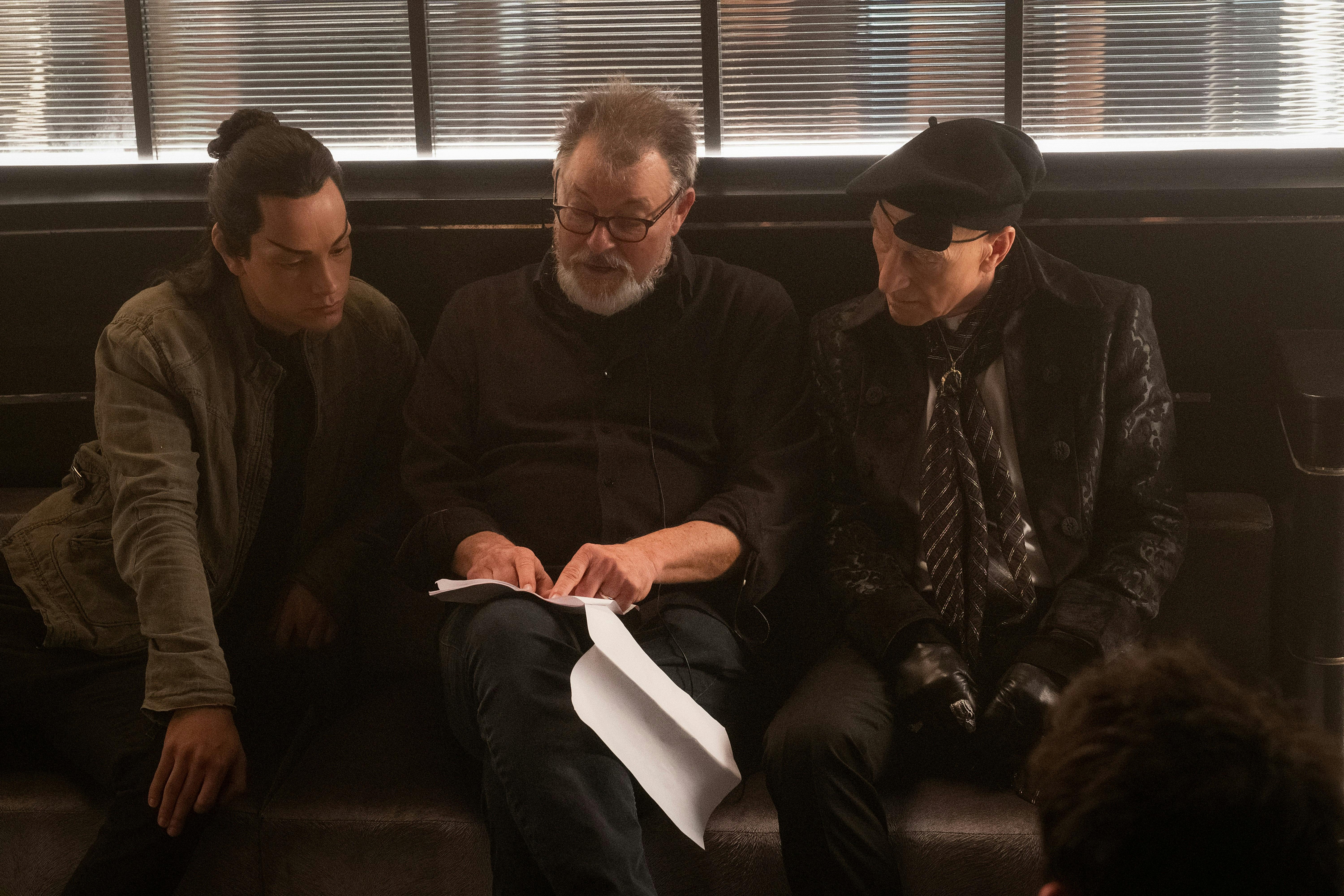Published Apr 12, 2022
Directing a Drama With Jonathan Frakes
Frakes reflects on his directorial debut 32 years ago

StarTrek.com | Getty Images
Jonathan Frakes. Few names command as much respect from the Star Trek community as the actor and director who portrayed William T. Riker (and his brother Thomas) on Star Trek: The Next Generation, Deep Space Nine, Voyager, Enterprise, Picard, Lower Decks, and four TNG movies. Frakes directed two of those features, including the critically-acclaimed Star Trek: First Contact. However, before he was helming blockbusters, Frakes made his directorial debut with “The Offspring,” a pivotal TNG episode.
StarTrek.com recently chatted with Frakes about becoming a director, creating “The Offspring,” working with the casts of Discovery and Picard, hearing the fan response to William T. Riker’s return to the bridge in Picard’s first season, and more.
StarTrek.com: At what point in your career did you take an interest in directing? Was there a specific moment that inspired the decision?
Jonathan Frakes: I had directed a couple of little things in college and enjoyed it, but only when I was on the set day after day on The Next Generation during season one did I realize that- as we all learn, a lot of making TV and making films is waiting. I could only take so many naps [laughs], so I used to hang around the set and I liked ‘the factory’ where we built things.
It always seemed to me that the hub was where the director was. So I asked Rick Berman if I could shadow, and I spent almost three years with all of those wonderful directors — Cliff Bole, Robert Scheerer, and Winrich Kolbe. It was eye-opening to see both how simple it seemed if you had great people working for you and how important it was to remember the story, remember the story, remember the story.
Rick was generous enough to let me hang out with the editors, which is the area that I knew very little about. I spent around 300 hours in the editing room trying to understand their science and craft. Those guys, including Tom Benko, J.P. Farrell, and Bob Lederman, they all wanted to be directors, as well. That’s the other thing, directors are generous, because they’ve already got the job. Editors want the same job you’re trying to get, so it’s particularly generous of them to share their time.
To this day, I’m much happier directing than acting. I’m much more comfortable in the chair.

StarTrek.com
Before you knew which episode you’d get, what was going through your mind when you learned you were going to have the opportunity to direct on TNG?
JF: Well, frankly, I felt I had put my time in. As I said, I had shadowed for the better part of two and a half years, and our seasons were 26 episodes each. I distinctly remember that I was living in Genie [Francis]’s house in Tarzana [California] before we were married, and one day I said, You know what, I’m not acting today. I think I’ll just stay home. She told me that’s exactly what Rick’s waiting for you to do. The minute you show any lack of interest, he’ll have a good excuse not to give you [the opportunity]. So I got my ass in the car and went to work [laughs].
Genie helped keep me on track. Rick was very generous, we kidded about it and called it ‘Paramount University,’ because it was all there. Eventually I got to go to the pre-production meetings, the casting sessions, visual effects sessions, concept meetings, and meetings with Herman Zimmerman and the art department. That whole family, which is still a huge part of my life, was frankly very supportive.
When I arrived on the set for the first day of shooting “The Offspring,” our soundman was Alan Bernard, and his son David gave me a megaphone — an old school, 1930s director’s megaphone, that the whole company had signed to wish me luck. I still have it, and that was the vibe.
I know you were happy to have a ‘Data episode’ to direct, but when did you realize that “The Offspring” would be a particularly special installment?
JF: Well, in addition to being a Data episode, it was René Echevarria’s first episode. As you know, he became one of our stalwarts, as well as a producer on Deep Space Nine. He was a member of that incredible writing staff that Ronald D. Moore, Ira Steven Behr, Nareen Shankar, Brannon Braga, and that group assembled. As the story has been told to me, [“The Offspring”] was his spec script that he had submitted to Michael Piller, who was generous enough to read unsolicited scripts from young writers. Michael was fabulous, and a wonderful piano player.
Hallie Todd, who played Lal, turned out to be genius. Nicolas Coster I had known from [soap operas], so I had really good guest stars. I had the support of the shooting company, and my friends in the cast just took the piss out of me all day, but delivered in a way that only friends can. It was a real lightning in a bottle situation for me.
Most people aren’t aware of the dedication involved in directing. Once you’re assigned an episode, what is the initial step in your process?
JF: Generally, the prep part of your life as a director continues to be the most important aspect. We start with the concept meeting, where the writer and the showrunners tell the director, the department heads, the editor, and a handful of people what the story as they see it is. So that sets the tone for the whole month of your life. Then comes the individual meetings with casting, costumes, props, stunts, visual and special effects, and more as the week goes on. Another important element is what I call DGA [Director’s Guild of America] Theatre, where you walk the set, you visualize where you think the actors will be, where the entrances and exits will be, and therefore you set your camera positions in your mind.
Bob Justman was a real advocate for me and a source of support, as well as a link back to The Original Series. He told me to never, ever go on the set without a shot list. All during prep, in my scripts, you’ll see shit in both columns where I’m writing down what I think. Transition shots, with which you transition in and out of scenes, are essential. The opening shot of each act is essential. I still use a paper script, though a lot of people have moved on to the big iPad that Olatunde Osunsanmi and Doug Aarniokoski use. I’m very attached to the tangibility of a paper script.

StarTrek.com
What is your final involvement once everything is in the can?
JF: After you’ve finished shooting the episode, there are four days in which the editor and the assistant editor finish the editor’s cut. You have three or four days with them to put together the director’s cut. Les Landau used to tell me you remember every shot you made, like in a golf game. So you might see a shot in the editor’s cut and remember that you had another take that you preferred. Sometimes you’re full of it because you just wish you had that shot [laughs].
As a director, the hardest thing to learn is that you turn in your director’s cut, and that’s the last time it’s really yours. A year later, or on Next Gen it was a few months later, you see what the producers and network have altered. A different bunch of cooks come in and, I wouldn’t say your show is unrecognizable, but sometimes things are changed in a way that disappoints you. Other times the changes make it better.
When you turn in your director’s cut, you need to know that you’ve done your best version of “The Offspring” or whatever episode it is that you can, and then I’d give it to Rick and whoever else was working on it. You always hope that they keep this or that in, but you really need to release that shit or you’ll have your heart broken [laughs].
On Discovery and Picard, you’ve helmed episodes that have featured everything from Seven of Nine’s return to a view of 32nd century Earth. Is there a scene or moment from these recent series that you feel privileged to have directed?
JF: Wow, excellent question. Working with Patrick [Stewart] and Brent [Spiner] on Picard was a treat. I’m thrilled to have been part of the emergence of Ethan Peck as Spock. Some of the scenes I did with he and Sonequa [Martin-Green] were so powerful, and he was so committed to creating that iconic character. The three of us worked the scenes in a way that laid the groundwork for how wonderful he is and part of the reason that Strange New Worlds is there with him, and Anson [Mount], and Rebecca [Romijn]. Ethan found that character, and I was excited to be a fly on the wall during that creation.
Star Trek is a universe you’re very familiar with, but the vast catalog of episodes can be overwhelming for actors who are new to the franchise. Do you offer any tips to people who’ve never been on a fake starship before?
JF: I do. Particularly, when I first went over to Discovery in season one, there was such a palpable familiarity between that cast and our family on Next Gen. They sat with me and really quizzed me about the feeling, and I told them about how their lives were going to change. The same is going to be true for the Strange New Worlds cast. It’s a gift, and I know the Disco crew gets it, because when I go back there I feel as if I’m visiting my other family.

StarTrek.com
What does it mean to you that, after having Riker appear in Picard and Lower Decks, so many fans have voiced their desire to see you reprise the role more often?
JF: It’s a thrill, and I’m game [laughs].
You’ve been doing some very crucial work with Armin Shimerman and Kitty Swink, your friends and Star Trek colleagues. Could you tell us about your involvement with the Pancreatic Cancer Action Network?
JF: I got involved with PanCan because my wonderful brother Daniel died rapidly from pancreatic cancer at the age of 41. My brother had a beautiful little girl and he was kind of my best friend. It was a very tragic part of my family’s life from which my father never truly recovered. He had Alzheimer’s afterwards, but my mother and I carried on and mourned him in a way that was helped by Kitty. I’ve known Armin and Kitty for about 35 to 40 years, and Kitty is an 18-year survivor of pancreatic cancer, which is one of the deadliest cancers out there.
When Daniel died, there was a 3% survival rate. When Kitty was diagnosed and survived, there was a 5% survival rate. Now, through PanCan’s work, there is a 10% survival rate, which is still abysmal- but we continue that work through our PurpleStride marathon team. I would tell my mom stories about my friend Kitty who survived, which somehow helped my mom digest Daniel’s death. There was a friend of our family who did survive. That gave me hope, it gave my mom, Doris, hope. We all love Kitty, but I love Kitty with that other special layer.
PanCan is my number one charity, that and the Alzheimer’s Association, which my dad suffered from. There are a lot of causes out there that we can hopefully help if we can throw some money at them and get the brilliant scientists on the job. I believe there’s a future in eliminating these diseases. The Star Trek connection doesn’t hurt, because we hold the vision of a positive future so dearly.
This interview has been edited and condensed.
Jay Stobie (he/him) is a freelance writer and consultant who has contributed articles to StarTrek.com, Star Trek Explorer, and Star Trek Magazine, as well as to Star Wars Insider and StarWars.com. Jay serves as a BoldlyGo Campaign Ambassador for The Roddenberry Foundation. Jay can be found on Twitter and Instagram at @StobiesGalaxy
Star Trek: Picard streams exclusively on Paramount+ in the U.S. and is distributed concurrently by Paramount Global Distribution Group on Amazon Prime Video in more than 200 countries and territories. In Canada, it airs on Bell Media’s CTV Sci-Fi Channel and streams on Crave.
Star Trek: Discovery currently streams exclusively on Paramount+ in the U.S. Internationally, the series is available on Paramount+ in Australia, Latin America and the Nordics, and on Pluto TV in Austria, France, Germany, Italy, Spain, Switzerland and the United Kingdom on the Pluto TV Sci-Fi channel. In Canada, it airs on Bell Media’s CTV Sci-Fi Channel and streams on Crave. Star Trek: Discovery is distributed by Paramount Global Distribution Group.
Star Trek: Lower Decks streams exclusively in the United States and Latin America on Paramount+, on Amazon Prime Video in Australia, New Zealand, Europe, Japan, India and more, and in Canada on Bell Media’s CTV Sci-Fi Channel and streams on Crave.
